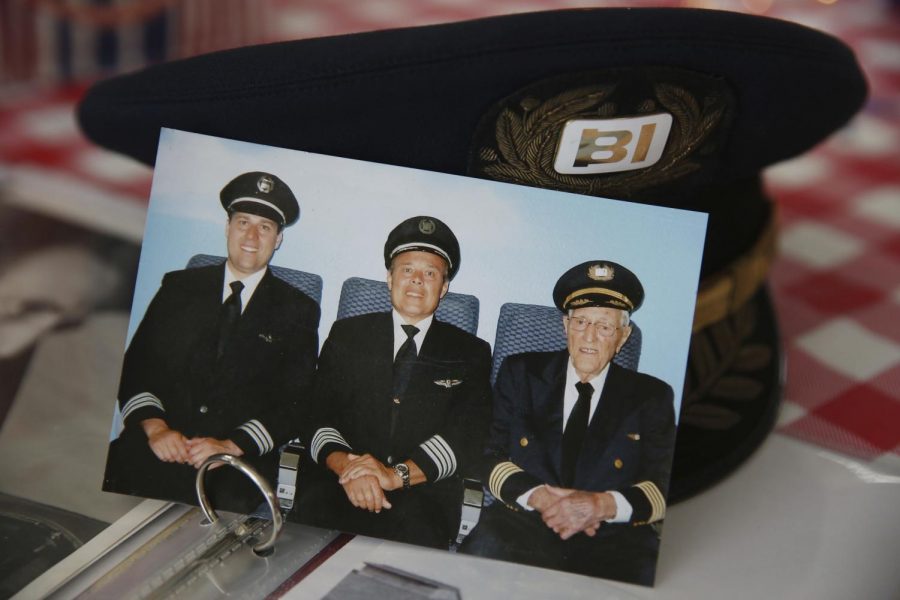Ex-Braniff Airways pilots, staff gather in Texas for final fly-in
ANDY JACOBSOHN/The Dallas Morning News
From left, Todd Pappas next to his father Bill Pappas and his grandfather Dow Matthews is displayed during the 41st annual Braniff International Airways pilots picnic at Denton Municipal Airport in Denton, Texas.
May 30, 2018
DENTON— It’s been more than three decades since Braniff International Airways grounded its fleet of 62 brightly colored aircrafts, bringing a sudden end to a Dallas icon and upending the lives of its 9,000 employees.
The Dallas Morning News reports once a year, every year since the carrier’s 1982 demise, former pilots, whether they stayed in Dallas or moved across the country for work at another airline, have gathered at an airport in North Texas to grill, show off their personal planes and swap stories of an unforgettable time in their lives.
“I use the term family. We have good memories, we always worked together, we’ve kept in contact,” said Bill Schoknecht, who joined Braniff in 1966 and is president of Braniff International Silver Eagles, the retired pilots group. “In some cases, this is the only time we see them during the year. But if they need us or we needed them, we can always call on each other.”
On Monday, the group held its 41st and final fly-in and picnic at the Denton Municipal Airport. The tradition started in the late 1970s as a gathering for retired pilots, but with Braniff’s closure in 1982, all of its pilots became retired from the carrier in a sense, and the group was expanded.
With no new pilots entering the pipeline, a gathering that once drew hundreds has dwindled with each passing year, as the realities of life — be it personal, financial or mortal — have taken their toll. “We know it has to happen, because of the restraints and all. But we’re really going to miss it,” Schoknecht said. “It’s something we always look forward to.”
Don Maynard joined Braniff Airways in 1951 as the carrier, founded in 1928, was preparing to make its ascent from an earlier generation of staid airlines that took cues from the military to a trailblazer of the Jet Age. “I left New Orleans, and everyone thought I was crazy,” said Maynard, now 89, who joined the carrier at a time when it still flew unpressurized aircraft. “The day I got hired, when I was put on the seniority list, I was 258.” Maynard describes it as a “wonderful time,” with the airline hiring rapidly to fuel its expansion and pilots pioneering never-before-operated commercial routes into South America.
John J. Nance, a Braniff pilot from 1975 to 1982 who authored a book about the company, described Braniff as an innovative mold breaker, an identity typified by the Technicolor hues the airline painted its planes and the elements of design and fashion it incorporated into its plane interiors, crew uniforms and lounges. “They were doing things that hadn’t been done before,” said Nance, author of “Splash of Colors: The Self-Destruction of Braniff International” and an aviation analyst for ABC.
Nance said the airline’s glamour, boldness and ascendancy mirrored that of its hometown. “This was a very Texas airline,” he said. “Dallas was a perfect location for Braniff. I think if it had been located in many other cities in the world, it wouldn’t have the same level of panache and success.”
The deregulation of the airline industry in 1978 created new opportunities for Braniff but also laid the groundwork for its ultimate demise. Faced with a newly open and rapidly changing airline landscape, Braniff’s executives decided the best course of action was to expand aggressively, adding 31 destinations over two years, according to the Texas State Historical Association.
But the planes weren’t full enough and gas prices were rising, leading to increasing flows of red ink on the carrier’s balance sheet year after year. In 1980, the airline lost $131 million.
On May 12, 1982, rumors started to spread about the carrier grounding its fleet, as pilots and crew were called and told their flights were canceled. By 6 p.m., it was national news. “The bankruptcy in 1982 was such a startling event,” said Maynard. “We’ve been able to keep it together since then. … The bankruptcy, that really made us feel nobody else has been through what we’ve been through.”
After the bankruptcy, pilots, flight attendants and other Braniff employees found themselves scattered as they hurriedly searched for new jobs. Schoknecht would end his career with Minnesota-based Northwest Airlines, Nance with Alaska Airlines. Maynard, further along in his career at the time, didn’t make it back into the cockpit but found work as a flight instructor at Fort Worth-based American Airlines. The Braniff name and some of its assets were resurrected two more times over the next decade, with each venture failing within a few years.
Through it all, the fly-in picnic and the bond it represents have persevered. This year, the invitation list was expanded to include flight attendants and other former Braniff employees, making for a large turnout for one final bash.
“We’re all proud of the other airlines we’ve worked for. We still say Braniff is the best,” Schoknecht said.
Even without the annual picnic, the retired pilots plan to keep the Braniff name alive as long as possible. There will still be monthly lunches in Dallas and other former crew bases. The website with Braniff employee information will stay online. And the group’s charity will still continue to raise funds for aviation education.
“We’ve had a lot” of gatherings,” Maynard said. “The first one started out in an old airport, Kittyhawk in Allen, that’s now closed. We had a nice run. We enjoy it and we enjoy each other’s company. We’ll still have meetings until the last guy dies, I guess.”



